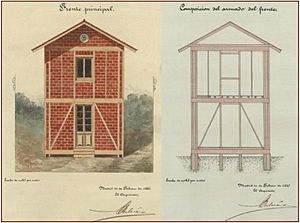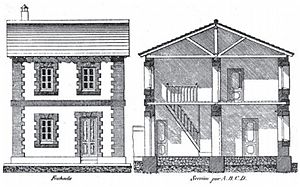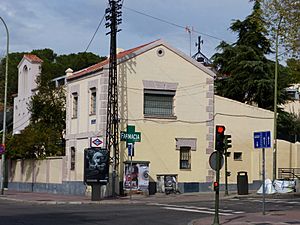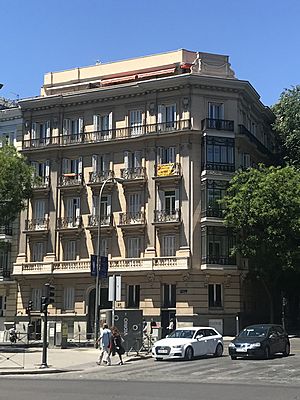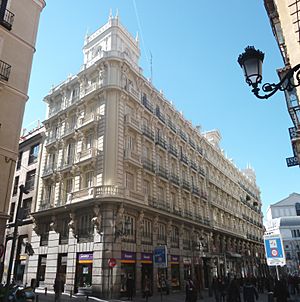Mariano Belmás Estrada facts for kids
Quick facts for kids
Mariano Belmás Estrada
|
|
|---|---|
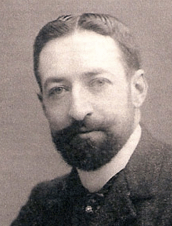 |
|
| Born | 17 January 1850 Madrid, Spain
|
| Died | 16 August 1916 (aged 66) |
| Nationality | Spanish |
| Occupation | Architect |
Mariano Belmás Estrada (born January 17, 1850 – died August 16, 1916) was a Spanish architect. He was very important in planning cities in Madrid during the late 1800s. He focused on finding ways to build homes for workers as the city grew and became more modern.
Mariano Belmás believed that architecture was about solving social problems with smart building ideas, not just making things look pretty. He was a main architect helping to rebuild after a big earthquake in Andalusia in 1884. He also helped start and design the Ciudad Lineal (Linear City) in Madrid, which was a specially planned neighborhood. Later in his career, he became a very successful architect. He designed many new and renovated buildings for both public and private clients.
Contents
Early Life (1850–1875)
Mariano Belmás Estrada was born in Madrid, Spain, on January 17, 1850. His father, Juan Belmás Vidal, was an engineer from Galicia. Mariano studied science and architecture at a school in Madrid. He finished his studies on October 16, 1873.
During his training, Spain was going through a period called the "Sexenio Democrático" (1868–1874). This was a time of big changes in government. His studies were influenced by exciting plans to develop Madrid, suggested by people like Ángel Fernández de los Ríos. After graduating, Mariano spent his first few years learning more about his profession and studying ideas, rather than actively building.
Thinking Big: His Ideas (1875–1885)
Belmás became very active in the Central Society of Architects. From 1875 to 1882, he was the general secretary of this group. In 1876, he became the editor of their magazine, Revista de la Arquitectura Nacional y Extranjera.
Around this time, a new law about building homes for working-class families made people interested in city planning and affordable construction. Belmás started to explore ideas about "architectural hygiene" (making sure buildings were healthy) and public housing (homes for everyone). In 1880, he showed designs for small, connected houses made with concrete walls. He believed city plans should use groups of these modest homes.
In 1880, Belmás received money from the government to visit England and Belgium. He went there to study how they built homes for workers and other low-cost buildings. When he came back, he helped start the Spanish Hygiene Society in 1881. He was the secretary of this society for several years. He also represented the society at international meetings about hygiene in Paris (1885) and London (1891). Because of his work, he became a special member of important architect groups in France and Britain.
Belmás shared his ideas about health, city planning, and affordable housing at the first National Congress of Architects in 1881. He talked about creating neighborhoods for working-class families with single homes. These homes would be connected to the city by new types of transportation. Also in 1881, he began to promote building affordable homes using his own "Belmás system" of modern construction.
His new ideas were not liked by everyone. Some traditional architects, like Lorenzo Álvarez Capra, disagreed with him at the 1881 congress. Because of these disagreements, Belmás left the Central Society in 1882. He also stopped working for their magazine. However, he continued to write articles for other magazines that discussed city planning, healthy urban living, and affordable homes. Belmás became known as one of the most forward-thinking experts in architecture and city development.
A few experimental, affordable workers' houses were built in Madrid in the following years. From 1881 to 1885, Belmás also worked on redesigning the Ministry of Development building in Madrid. In 1882, he started the Constructora Mutua (Mutual Construction Company). This was a group that aimed to build cheap housing. However, they didn't have enough money, so only a few houses were built.
Helping After the Earthquake (1885–1886)
After a big earthquake hit Andalusia on December 25, 1884, Belmás became an official helper for the government's rebuilding efforts on January 26, 1885. For the rest of that year, he worked in Madrid and in the affected areas. He was the main technical expert for the royal commission in charge of rebuilding.
Belmás set the rules for how the official reconstruction should happen. He helped create a competition in February for "housing plans for the communities that need to be rebuilt in the provinces of Málaga and Granada." The rules of the competition required the plans to follow his ideas for standardized city architecture. In February 1885, the government asked Spanish architects to design new homes for the poor. These homes had to cost no more than 1,500 pesetas and be very strong against future earthquakes.
Belmás submitted his own design. It used building ideas that had already been partly used by José Grases Riera. He called his system an "articulated skeleton." This meant it had a flexible wooden frame filled with cheap materials like bricks or adobe. This made a "solid, strong, and flexible unit." It didn't even need a deep foundation.
Belmás said his design had perfect connections between all its parts. This meant that even if the ground shook, the house could sway but wouldn't break. He wrote that "even if the house fell and rolled, its frame would remain locked like a boat that suffered the hard attacks of the raging waves of the sea." However, the people who were supposed to live in these houses were not sure if the new design would be strong or practical. Other famous architects also doubted if the houses would be good enough for the region's tough climate.
There is no official record that Belmás won the contest. Some say a different plan was chosen. But preparations were made to build based on his model. A test house was built in Madrid, and parts for some houses were sent to the earthquake areas to be put together. Belmás Estrada's five designs used similar building methods and were between 40 and 150 square meters in size. The houses had strong foundations, sturdy frames, and reinforced corners to prevent collapse.
Belmás helped with the rebuilding in Alhama de Granada, but he could only build a small neighborhood there. Towards the end of 1885, José Marín-Baldo y Cachia joined the commission. He had a lot of experience from rebuilding villages after a big flood in 1880. Belmás seems to have left the commission in January 1886.
Building Homes in Madrid (1887–1897)
In 1887, Belmás tried to manage a new development in Madrid's Pacífico neighborhood. He even built a house for himself there. But the project faced money problems. Also in 1887, he worked on adding to the Palacio de Altamira. His design completed a part of the building's front that was unfinished.
Between 1890 and 1896, Belmás was involved in a project to build a neighborhood of townhouses called "Madrid Moderno." This project faced many official delays. Madrid Moderno was built between 1890 and 1897 on empty land outside the city's eastern border. It was built in stages and designed for middle-class families. It had about 100 two-story houses, each with a small garden in front. The outside of the buildings used a mix of brick, wood, metal, and ceramics, giving them an attractive and varied look. Most of these houses have since been torn down to make way for newer buildings.
The Madrid Urbanization Company was started on March 3, 1894. It had a lot of money and plans for 67 kilometers of tram lines. Arturo Soria y Mata helped create this company. Mariano Belmás Estrada was one of the first people on its board of directors. In 1894, he played a very important role in starting and developing the Ciudad Lineal (Linear City) urban plan, which was promoted by this company.
The Ciudad Lineal aimed to give every family a house with an orchard and a garden. However, the way the houses were designed ended up sorting families by their social class. Belmás designed and built some of the project's main buildings, including the company's offices and different types of houses, even luxury ones. He owned shares in the company and was on its board until 1898. He left after a disagreement with Soria. In 1896, Belmás helped organize the first "Festival of Trees" in Madrid.
Later Years (1897–1916)
Belmás became a member of the Liberal political party. From 1897 to 1906, he was a representative for Madrid. Later, he became a senator for the Province of Lugo.
Belmás gave advice to Fernando Navarro for building the Palacete Rodriguez Quegles in Las Palmas, Gran Canaria. This was a small, fancy building in the Art Nouveau style. Navarro finished Belmás's proposed design in 1900. In the 1900s, Belmás moved away from his earlier, more idealistic ideas. Most of his well-known buildings from this time used a mix of different styles, known as the eclectic style.
He designed homes for important families:
- The Marquis de Valdeterrazo on calle Hortaleza (1902–1904)
- The Mitjans family on calle Velázquez (1904–1905) and on the Paseo de la Castellana (1907)
- Luis de la Mata on Felipe II avenue (1905–1909)
- José Rivas on Calle Lagasca (1911–1914), which was finished by another architect, Francisco Reynals.
Belmás also redesigned Madrid's famous Gran Hotel de Arenal. The building at Arenal 19 was originally designed in 1862. Belmás Estrada renovated it between 1907 and 1908 to turn it into the International Hotel. He added many details to the outside that were considered very stylish and French at the time. In 1909, Belmás restructured the Ave Maria Chapel, which was the last part of the Trinity Convent in Madrid. He added a new floor and changed the outside to match.
In his final years, Belmás was highly respected. He received a special award called the Grand Cross of the Order of Isabella the Catholic. He also helped create the rules in 1911 for building single-family public houses in Madrid. Mariano Belmás Estrada passed away on August 16, 1916. In the 1920s and 1930s, architects in Madrid continued to try and solve the problem of creating good working-class neighborhoods, but they had little more success than Belmás and others before him.
Sources
See also
 In Spanish: Mariano Belmás Estrada para niños
In Spanish: Mariano Belmás Estrada para niños


